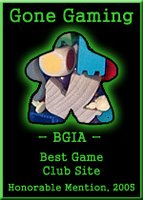The theme for this week was explosions – and the happenings of the evening fit the theme. Starting with our explosive meal of chilli and “Caramel Explosion” ice cream, we dove right into Zero!
Having played this game in several different sessions now, we’re finally getting the hang of it. We decided to go with match play, with one element each of a P-40E and a P-40D vs. two elements of Zeroes for the first fight, then switching sides for the second. On one team was Easy and Kozure (IJN), on the other was Shemp and Hapi (USAF). The battle was spread over the skies, with elements pairing off against each other at High and Low altitudes. Eventually both pairs met up at middle altitude, and both sides lost two aircraft each, tying the game.
With Easy and Kozure now sitting in the American planes, the second battle started with both of the Yanks at medium altitude, but the Japanese were spread out at Very High and Low. The four Warhawks dove down on Hapi’s hapless Zekes, Hapi losing one aircraft to Kozure’s fire before managing to climb out of the fight to meet up with Shemp diving from above. In the swirling furball which followed, Shemp first lost an aircraft to a fuel tank explosion, and Hapi lost his second paper kite to another sniper shot fuel tank explosion by Easy.
Shemp managed to stay alive to the end of the fight, but the match was decided… three aircraft down vs. none. In match play, the Kozure/Easy team took the ring.
The second game(s) of the night was the Battle Cry/Memoir ’44 system – both essentially the same system with minor cosmetic tweaks suitable to the time period; both rulesets were designed by Richard Borg. Battle Cry was the earlier offering from the Hasbro/Avalon Hill line in 2000, with Memoir ’44 coming out from Days of Wonder in 2004.
The system used by both games works on a very simple turn order. Play a command card, order the units indicated by the card, move the ordered units, battle with the ordered units, then draw a new card. Each player can have a command/control advantage if he or she has more or less command cards as dictated by the scenario. The board is divided into three sections, the left flank, the right flank and the centre. Command cards refer to those sections or combinations thereof. Some cards allow special effects to occur, and in Memoir ’44, the “Ambush” card allows an “interrupt” of sorts. Movement is simple – three hexes for tanks and cavalry, one hex and battle for infantry (two if they don’t battle in Memoir ’44) and move one or battle for artillery. The generals, unique to Battle Cry, move three hexes. Terrain affects movement in a variety of ways, typically making it impossible to fire after moving into most terrains except hills.
Battling is the simple case of rolling a number of dice, modified by range, and trying to roll the silhouette of the targeted unit. Some results (crossed swords in Battle Cry and a grenade in Memoir ’44) are wild-card hits. Memoir has the addition die-face result of “star” which has a special effect for some cards.
Having played several game sessions on Wednesday, Friday and Saturday, my recollection of the battles were hazy, but a few quick e-mails pointed me back in the right direction. I played Easy at Memoir ’44 as the dilatory Germans in the introductory “Pegasus Bridge” scenario and lost 4 flags to 6. Playing as the Union, Shemp crushed Hapi in the First Bull Run scenario in Battle Cry, 6 medals to 2. Everyone seemed to enjoy the games, so I think they’ll make another appearance.
The last game of the evening was the admittedly silly Unexploded Cow. France has too much unexploded ordinance left over from WWII. England has too many cows infected with mad-cow disease. The solution? Start a business using cows to detonate the bombs! Yes, this has to be one of the more politically incorrect games we can play (along with Puerto Rico’s brown “colonists”) but it is fun.
The game is more or less an investment vs. risk system, wherein each player “invests” a portion of his stake every turn (buying various ranks and types of cows), then rolls a die to see if it pays off (they set off a bomb). Strategy enters the game in the form of certain cows with special abilities, and the ability to play cows with negative payoffs into opposing players’ fields. It’s quick and dirty, and the illustrations are fun. We tried two styles: the basic version, where the point value of the city being rescued is random, and the “strategic version”, where the point value of the city increases by one each turn. Strangely, the group preferred the random version, as it seemed to fit the random nature of the game. Hapi won both games, and Shemp finished last. Easy and I switched places, I believe, for second and third place in the two games.
EDIT: The correct sequence was Game 1: Hapi, Kozure, Shemp, Easy; Game 2: Easy, Hapi, Kozure, Shemp
Unexploded Cow is pretty light – almost too light - but it is entertaining, and that’s the key.
All in keeping with the theme, everything blowed up real good.

